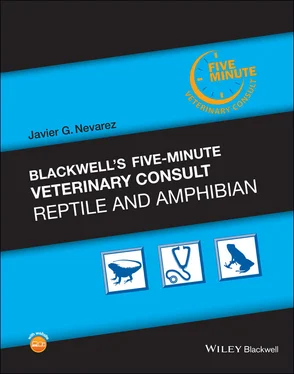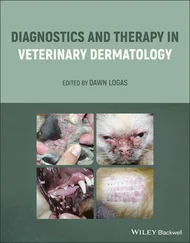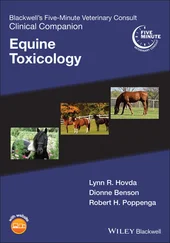Ophthalmic antibiotic drops may be instilled in the canal for local therapy in addition to the use of systemic antibiotics.
The use of ointments should be reserved for the period when all the material can be easily flushed out of the canal.
Some may elect to administer vitamin A (5,000–10,000 iu IM as a single dose), but this should be reserved for the most severe cases, as hypervitaminosis A from parenteral administration is a concern.
Natural sources of vitamin A in the diet (herbivorous—parsley, carrot, tomato, spirulina; carnivorous—liver, fish, eggs).
CLIENT EDUCATION/HUSBANDRY RECOMMENDATIONS
Ensure a proper balanced diet for the species and consider oral vitamin A supplementation at a rate of 2–8 iu/g of feed.
Improve hygiene to decrease bacterial load in the water/enclosure.
Avoid fights or scratches among animals housed together.
The debridement must be performed with the animal under sedation or anesthesia with proper analgesia (NSAIDs and opioids, local block, etc.).
The tympanic membrane can then be incised either in a vertical or horizontal manner.
A horizontal incision on the ventral aspect of the membrane may allow for better drainage postoperatively.
The tympanic membrane is usually edematous and vascularized leading to appreciable bleeding upon incision.
If excessive bleeding occurs, topical hemostatics (silver nitrate) may be used.
Once an opening is made, the caseous material must be removed in its entirety via manual manipulation and flushing.
Chelonian ears have an inverted L shape, which means that there is often a dorsocaudal pocket that harbors more material.
A cotton‐tip applicator can be placed on the dorsocaudal aspect of the head/ear followed by applying pressure in a cranioventral direction, to help expel the material.
Forceps are also helpful to remove excess material.
It is not uncommon to remove a volume of material two to three times the size of the external swelling.
Once the material is removed, the ear canal can be flushed with a disinfectant solution (iodine, chlorhexidine, etc.) and saline.
The membrane is left open to heal by secondary intention.
The ear canal can continue to be flushed once to twice daily until it closes.
 MEDICATIONS
MEDICATIONS
DRUG(S) OF CHOICE
Antibiotics: broad‐spectrum antibiotics (fluoroquinolones, cephalosporins) until resolution of clinical signs.
Preventive vitamin A is recommended at 1000–2000 iu/kg every 7 days, but is best done by dietary supplementation at 2–8 iu/g of feed) to avoid overdosing.
With preventive vitamin A it is advisable to use a minimum dose.
Overdosage of oily vitamin A causes exostosis, hepatomegaly, and skin lesions.
 FOLLOW‐UP
FOLLOW‐UP
PATIENT MONITORING
A thorough physical examination will confirm the healing of the tympanic membrane.
It usually takes between 2 and 4 weeks.
If vitamin A has been provided, no further relapses are expected.
EXPECTED COURSE AND PROGNOSIS
Generally carries a good prognosis.
Balance is not usually affected, although cases may be observed depending on the degree of injury to the inner ear.
 MISCELLANEOUS
MISCELLANEOUS
COMMENTS
Recent research suggests that 6 months of exposure to selected organochlorine compounds (chlordane, aroclor, lindane), or similar duration of reduced dietary vitamin A concentrations, did not influence the formation of squamous metaplasia and aural abscesses in red‐eared sliders (Trachemys scripta).
Although the etiopathogenesis of otitis is known, there are probably more factors involved in the onset of this disease.
N/A
Otic abscess
Otitis
IM = Intramuscular
NSAIDs = nonsteroidal anti‐inflammatory drugs
Center for Avian and Exotic Medicine. Aural Abscesses in Aquatic Turtles. http://avianandexoticvets.com/aural‐abscesses‐in‐aquatic‐turtles
Kik, M JL. Adenovirus infection in reptiles. EAZWV Transmissible Disease Fact Sheet, sheet no. 2, April 2009. https://www.eazwv.org/page/inf_handbook
PetMD Editorial. Ear Infections in Turtles and Tortoises. PetMD July 24, 2008. http://www.petmd.com/reptile/conditions/ears/c_rp_ear_infections
1 Christiansen JL, Grzybowski JM, Rinner BP. Facial lesions in turtles, observations on prevalence, reoccurrence, and multiple origins. J Herpetol 2004; 37:293–298.
2 De la Navarre BJS. Diagnosis and treatment of aural abscesses in turtles. Proc ARAV 2000; 7:9–13.
3 Kroenlein KR, Sleeman JM, Holladay SD, et al. Inability to induce tympanic squamous metaplasia using organochlorine compounds in vitamin A‐deficient red‐eared sliders (Trachemys scripta elegans). J Wildl Dis 2010; 44:664–669.
4 McKlveen TL, Jones CJ, Holladay SD. Radiographic diagnosis: aural abscesses in a box turtle. Vet Radiol Ultrasound 2000; 41(5):419–421.
AuthorAlbert Martínez‐Silvestre, DVM, MSc, PhD, DECZM (Herpetology), EBVS European Veterinary Specialist in Herpetological Medicine and Surgery, Acred. AVEPA (Exotic Animals)
Balantidium
 BASICS
BASICS
DEFINITION/OVERVIEW
Balantidium is a large ciliated protozoal organism that resides within the gastrointestinal tract. The trophozoite is elliptical in shape and ranges in size from 30–300 × 25–120 μm. It is densely covered with cilia along its surface. At the tapered front end lies the cystostome (mouth). Cysts have a thick wall, spherical in shape, and have a kidney bean‐shaped macronucleus. Balantidium testudinis is a species commonly reported in turtle species. They are typically found in herbivorous reptiles. It is debated whether these organisms are considered commensal within reptiles.
Transmission is through the fecal–oral route.
Cysts are ingested and then undergo excystation in the intestinal tract.
Trophozoites inhabit the large colon and replicate by binary fission.
Trophozoites undergo encystation in which infective cysts are formed and then excreted in feces.
Balantidium sp. are facultative parasites and only become pathogenic when other virulence factors such as hyaluronidase are present.
This then allows them to penetrate the intestinal mucosa and cause extensive hemorrhage and necrosis.
Balantidium is generally limited to the large intestinal tract.
In severe infections, the protozoal organisms migrate to the liver and cause abscessation.
Читать дальше

 MEDICATIONS
MEDICATIONS FOLLOW‐UP
FOLLOW‐UP MISCELLANEOUS
MISCELLANEOUS BASICS
BASICS










